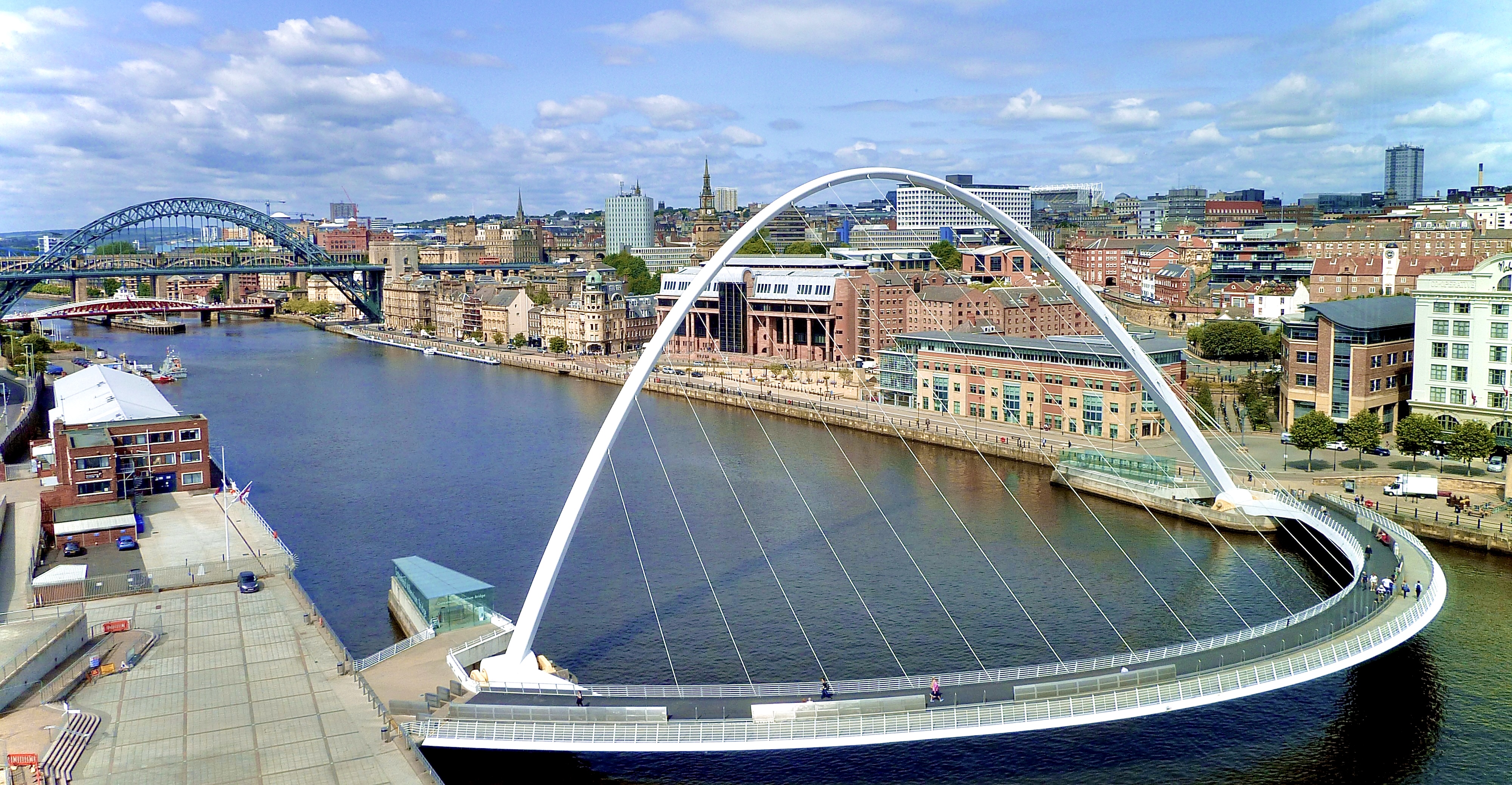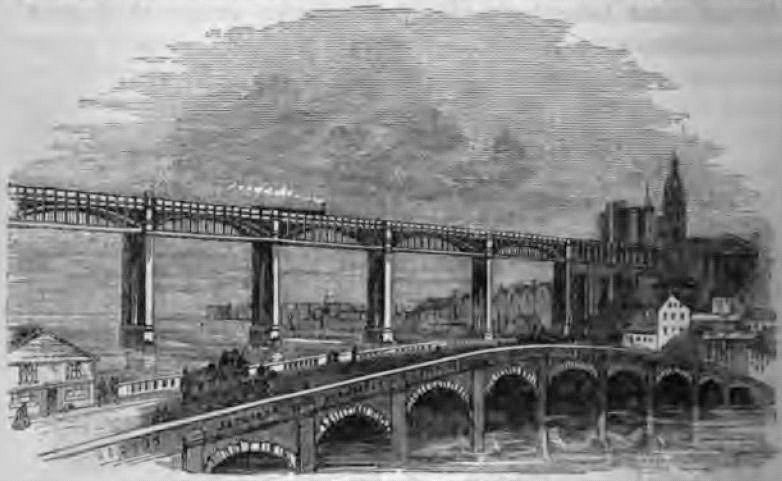|
Quayside
The Quayside is an area along the banks ( quay) of the River Tyne in Newcastle upon Tyne (the north bank) and Gateshead (south bank) in Tyne and Wear, North East England, United Kingdom. History The area was once an industrial area and busy commercial dockside serving the area, while the Newcastle side also hosted a regular street market. In recent years the docks became run-down, and the area has since been heavily redeveloped to provide a modern environment for the modern arts, music and culture, as well as new housing developments (e.g. at St Peter's Marina). Along the Newcastle side is an area that houses restaurants, bars and night clubs as well as housing and the Newcastle Law Courts. The NewcastleGateshead initiative now lists the Quayside as a top ten attraction. The Gateshead side of the river is designated and signposted as Gateshead Quays. It is the site of the BALTIC Centre for Contemporary Art and The Sage Gateshead performing arts and conference centre. Also m ... [...More Info...] [...Related Items...] OR: [Wikipedia] [Google] [Baidu] |
Newcastle Upon Tyne
Newcastle upon Tyne ( RP: , ), or simply Newcastle, is a city and metropolitan borough in Tyne and Wear, England. The city is located on the River Tyne's northern bank and forms the largest part of the Tyneside built-up area. Newcastle is also the most populous city of North East England. Newcastle developed around a Roman settlement called Pons Aelius and the settlement later took the name of a castle built in 1080 by William the Conqueror's eldest son, Robert Curthose. Historically, the city’s economy was dependent on its port and in particular, its status as one of the world's largest ship building and repair centres. Today, the city's economy is diverse with major economic output in science, finance, retail, education, tourism, and nightlife. Newcastle is one of the UK Core Cities, as well as part of the Eurocities network. Famous landmarks in Newcastle include the Tyne Bridge; the Swing Bridge; Newcastle Castle; St Thomas’ Church; Grainger Town including G ... [...More Info...] [...Related Items...] OR: [Wikipedia] [Google] [Baidu] |
QuayLink
QuayLink was a bus service in Tyne and Wear, England, which connected Gateshead and Newcastle upon Tyne, and later North Tyneside, with the Quayside. Funded by the Tyne and Wear Passenger Transport Executive, the service was launched on 22 July 2005. Operated initially by Stagecoach North East, the service was transferred to Go North East in July 2010 – later being operated commercially from July 2015, following budget cuts. History QuayLink was designed as a frequent, high quality bus service, for the newly developed and expanding Quayside area. Despite being located a short distance from the town centre of Gateshead and city centre of Newcastle upon Tyne, the area was poorly served by public transport. In June 2002, both Gateshead Council and Newcastle City Council, along with the Tyne and Wear Passenger Transport Executive, invited tenders for operation of a proposed Tyne Quayside Link, as well as the manufacture of eight alternatively-fuelled buses. The proposed proje ... [...More Info...] [...Related Items...] OR: [Wikipedia] [Google] [Baidu] |
BALTIC Centre For Contemporary Art
Baltic Centre for Contemporary Art (also known simply as (the) Baltic, stylised as BALTIC) is a centre for contemporary art located on the south bank of the River Tyne in Gateshead, Tyne and Wear, England. It hosts a frequently changing variety of exhibitions, events, and educational programmes with no permanent exhibition. The idea to open a centre for contemporary arts in Gateshead was developed in the 1990s, which was a time of regeneration for the local area—the Sage and Gateshead Millennium Bridge was also being conceived of in this period. Baltic opened in July 2002 in a converted flour mill, which had operated in various capacities from 1950 to 1984. The architectural design of Baltic was devised by Dominic Williams of Ellis Williams Architects, who won a competition to design the new contemporary arts centre in 1994. The building features exhibition spaces, a visitor centre, a rooftop restaurant and external viewing platforms which offer views of the River Tyne. Balt ... [...More Info...] [...Related Items...] OR: [Wikipedia] [Google] [Baidu] |
Customs House, Newcastle Upon Tyne
The Customs House is a Grade II* listed building on the Quayside in Newcastle upon Tyne. History The building was built in 1766 and then altered and re-fronted by Sydney Smirke in 1833. It replaced an earlier facility for the collection of customs duties at the west end of Quayside. The royal coat of arms above the front door dates to the late Georgian era The Georgian era was a period in British history from 1714 to , named after the Hanoverian Kings George I, George II, George III and George IV. The definition of the Georgian era is often extended to include the relatively short reign of Will .... The building is now occupied by barristers' offices. References {{reflist Buildings and structures in Newcastle upon Tyne Grade II* listed buildings in Tyne and Wear Custom houses in the United Kingdom ... [...More Info...] [...Related Items...] OR: [Wikipedia] [Google] [Baidu] |
Gateshead
Gateshead () is a large town in northern England. It is on the River Tyne's southern bank, opposite Newcastle to which it is joined by seven bridges. The town contains the Millennium Bridge, The Sage, and the Baltic Centre for Contemporary Art, and has on its outskirts the twenty metre tall Angel of the North sculpture. Historically part of County Durham, under the Local Government Act 1888 the town was made a county borough, meaning it was administered independently of the county council. Since 1974, the town has been administered as part of the Metropolitan Borough of Gateshead within Tyne and Wear. In the 2011 Census, town had a population 120,046 while the wider borough had 200,214. Toponymy Gateshead is first mentioned in Latin translation in Bede's '' Ecclesiastical History of the English People'' as ''ad caput caprae'' ("at the goat's head"). This interpretation is consistent with the later English attestations of the name, among them ''Gatesheued'' (c. 1190), ... [...More Info...] [...Related Items...] OR: [Wikipedia] [Google] [Baidu] |
Gateshead Millennium Bridge
The Gateshead Millennium Bridge is a pedestrian and cyclist tilt bridge spanning the River Tyne between Gateshead arts quarter on the south bank and Newcastle upon Tyne's Quayside area on the north bank. It was the first tilting bridge ever to be constructed. Opened for public use in 2001, the award-winning structure was conceived and designed by architectural practice WilkinsonEyre and structural engineering firm Gifford. The bridge is sometimes called the 'Blinking Eye Bridge' or the 'Winking Eye Bridge' due to its shape and its tilting method. The Millennium Bridge stands as the twentieth tallest structure in the city, and is shorter in stature than the neighbouring Tyne Bridge. History Historical context Gateshead Millennium Bridge is part of a long history of bridges built across the River Tyne, the earliest of which was constructed in the Middle Ages. As quay-based industries grew during the Industrial Revolution and Victorian era due to its accessible port, the ... [...More Info...] [...Related Items...] OR: [Wikipedia] [Google] [Baidu] |
The Sage Gateshead
Sage Gateshead is a concert venue and musical education centre in Gateshead on the south side of the River Tyne in North East England. Opened in 2004 and occupied by North Music Trust it is part of the Gateshead Quays development which includes the Baltic Centre for Contemporary Art and the Gateshead Millennium Bridge. Its name honors a patron: the accountancy software company The Sage Group. History Planning for the centre began in the early 1990s, when the orchestra of Sage Gateshead, Royal Northern Sinfonia, with encouragement from Northern Arts, began working on plans for a new concert hall. They were soon joined by regional folk music development agency Folkworks, which ensured that the needs of the region's traditional music were taken into consideration and represented in Sage Gateshead's programme of concerts, alongside Rock, Pop, Dance, Hip Hop, classical, jazz, acoustic, indie, country and world, Practice spaces for professional musicians, students and amat ... [...More Info...] [...Related Items...] OR: [Wikipedia] [Google] [Baidu] |
River Tyne
The River Tyne is a river in North East England. Its length (excluding tributaries) is . It is formed by the North Tyne and the South Tyne, which converge at Warden Rock near Hexham in Northumberland at a place dubbed 'The Meeting of the Waters'. The Tyne Rivers Trust measure the whole Tyne catchment as , containing of waterways. Course North Tyne The North Tyne rises on the Scottish border, north of Kielder Water. It flows through Kielder Forest, and in and out of the border. It then passes through the village of Bellingham before reaching Hexham. South Tyne The South Tyne rises on Alston Moor, Cumbria and flows through the towns of Haltwhistle and Haydon Bridge, in a valley often called the Tyne Gap. Hadrian's Wall lies to the north of the Tyne Gap. Coincidentally, the source of the South Tyne is very close to those of the Tees and the Wear. The South Tyne Valley falls within the North Pennines Area of Outstanding Natural Beauty (AONB) – the second larges ... [...More Info...] [...Related Items...] OR: [Wikipedia] [Google] [Baidu] |
Tyne Bridge
The Tyne Bridge is a through arch bridge over the River Tyne in North East England, linking Newcastle upon Tyne and Gateshead. The bridge was designed by the engineering firm Mott, Hay and Anderson, who later designed the Forth Road Bridge, and was built by Dorman Long and Co. of Middlesbrough. The bridge was officially opened on 10 October 1928 by King George V and has since become a defining symbol of Tyneside. It is ranked as the tenth tallest structure in Newcastle. History of construction The earliest bridge across the Tyne, Pons Aelius, was built by the Romans on the site of the present Swing Bridge around 122. A series of wooden bridges were lost to fire or flood, and plans for a stone bridge were begun in about 1250 with support from local landowners, and the Bishops of Durham, York and Caithness. The stone bridge was constructed but then damaged by flood in 1339. Repairs proved costly and took place in sections: it was not fully repaired, as a part stone and p ... [...More Info...] [...Related Items...] OR: [Wikipedia] [Google] [Baidu] |
The Sage
The Sage is a forthcoming indoor arena and conference centre in Gateshead, United Kingdom due to open in Autumn 2024. The site is located between the existing Sage Gateshead venue and the Baltic Centre for Contemporary Art on Gateshead Quayside. The arena is being built to replace the nearby 11,000 capacity Utilita Arena Newcastle that was originally opened in 1995. Name and history The venue is named for The Sage Group, a British multinational enterprise software company based in Newcastle upon Tyne, who agreed a £10 million deal for the naming rights. As of 2022 the Sage Group are currently patrons of the next-door Sage Gateshead venue which announced that they will be finding a new name for the 2004 building. Gateshead Council announced plans to redevelop the vacant site in 2014 and at that time the aim was for a mixed use development. The development is likely to cost £300 million. Preparatory works on the site began in late 2021. HOK are the architects of the co ... [...More Info...] [...Related Items...] OR: [Wikipedia] [Google] [Baidu] |
Tyne And Wear
Tyne and Wear () is a metropolitan county in North East England, situated around the mouths of the rivers Tyne and Wear. It was created in 1974, by the Local Government Act 1972, along with five metropolitan boroughs of Gateshead, Newcastle upon Tyne, Sunderland, North Tyneside and South Tyneside. It is bordered by Northumberland to the north and Durham to the south; the county boundary was formerly split between these counties with the border as the River Tyne. The former county council was based at Sandyford House. There is no longer county level local governance following the county council disbanding in 1986, by the Local Government Act 1985, with the metropolitan boroughs functioning separately. The county still exists as a metropolitan county and ceremonial purposes, as a geographic frame of reference. There are two combined authorities covering parts of the county area, North of Tyne and North East. History In the late 600s and into the 700s Saint Be ... [...More Info...] [...Related Items...] OR: [Wikipedia] [Google] [Baidu] |
Sydney Smirke
Sydney Smirke (20 December 1797 – 8 December 1877) was a British architect. Smirke who was born in London, England as the fifth son of painter Robert Smirke and his wife, Elizabeth Russell. He was the younger brother of Sir Robert Smirke and Sir Edward Smirke, who was also an architect. Their sister Mary Smirke was a noted painter and translator. He received the RIBA Royal Gold Medal in 1860. He became an associate of the Royal Academy in 1847 and was elected a full Academician in 1859. He served as RA Treasurer from 1861 to 1874, and was professor of Architecture from 1860 to 1865. Personal life He married Isabella Dobson, daughter of Newcastle upon Tyne architect John Dobson on 8 December 1840 at Newcastle upon Tyne. Among Smirke's numerous apprentices was the successful York architect George Fowler Jones. Smirke's works Sydney Smirke's works include: * Customs House, High Street, Shoreham-by-Sea (1830) * Customs House (refronting), Quayside, Newcastle upon Tyne, ( ... [...More Info...] [...Related Items...] OR: [Wikipedia] [Google] [Baidu] |








